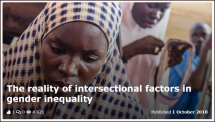The Reality of Intersectional Factors in Gender Inequality
In 2017, Islamic Relief Worldwide piloted protective and inclusive programming in six countries. For the pilots, the humanitarian organization created several tools, including an intersectionality framework to help understand gender identities, their social positions and immediate and strategic impacts.
To identify the women at risk of exclusion, Islamic Relief started using a model based on a gender analysis of power and influence.
The model analyzes the underlying power structures that define public discourse; as everybody carries multiple identities, there is a tendency not to immediately spot factors that render women most liable to discrimination.
Source: European Union Capacity for Development
Date of Publication: July 19, 2021
SIMILIAR RESOURCES
Tools
Examples
- Training Toolkit on MSM Programming for the MENA Region
- FGM Infographics
- Entertainment-Education Curriculum
- Noora Health COVID-19 Resources
- COVID-19 Exposes the Harsh Realities of Gender Inequality in Slums
- Gender Norms, Intersectionality and Social Protection: In Conversation with UNICEF's Dr Zahrah Nesbitt-Ahmed
- The Health Stigma and Discrimination Framework: A Global, Crosscutting Framework to Inform Research, Intervention Development, and Policy on Health-related Stigmas
- Intersectionality: Reflections from the Gender & Development Network
- Intersecting inequalities: Gender Equality Index
- Gender Implications for Extension and Advisory Services during COVID-19
- The Reality of Intersectional Factors in Gender Inequality
- Arab Women Speak Out: Profiles of Self Empowerment
- Evaluation of the COMPRI-A Social Marketing Program by USAID in the Islamic Republic of Afghanistan
- Communication for Healthy Living: Egypt - Legacy Video
- Beyond Bias Literature Review and Expert Interviews on Provider Bias in the Provision of Youth Contraceptive Services:

